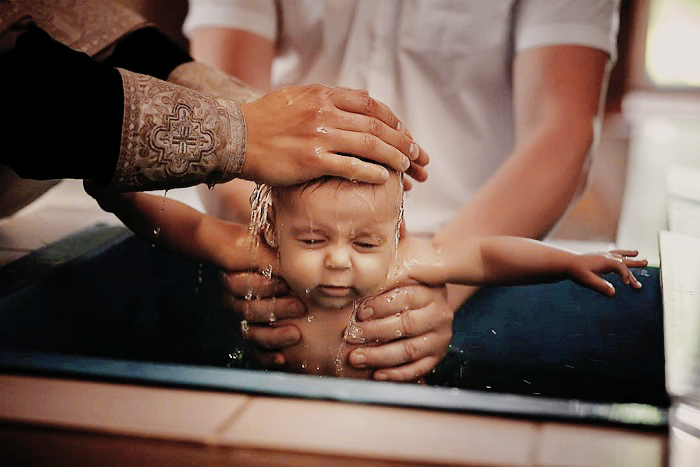
Speaking of the correct baptismal practice: by immersion or by sprinkling, it is worth pointing out the following. For one thing, the word “baptism” itself is translated from Greek as immersion. The Sacrament itself symbolizes the death and the new birth of a person: a death for sin and a birth in Christ. Thus, St. Basil the Great notes: “Water signifies death, as though it were a coffin. The bodies of those baptized in water seem to be buried: In whom (that is, in Christ – Author’s note) also ye are circumcised with the circumcision made without hands, in putting off the body of the sins of the flesh by the circumcision of Christ: Buried with him in baptism, wherein also ye are risen with him through the faith of the operation of God, who hath raised him from the dead. (Colossians 2:11-12).” Thus, we see that baptism by immersion is more consistent with the theological meaning of the sacrament.
On the other hand, it is not always possible to baptize by immersion, primarily because of the absence of special baptistery facilities in many temples. We need to realize that the validity of the Sacrament of Baptism does not depend on the amount of water used for it, since the main requirement is the faith of the person being baptized (or their godparents) and their desire to change their life and let the Lord Jesus Christ into it.
Furthermore, there are stories in the ancient Patericons about certain ascetics in the desert who baptized people with sand for lack of water. None of the holy fathers forced these Christians to be re-baptized by full immersion later. We know from the hagiography that many of the martyrs were baptized with blood, i. e. they did not technically go through the Sacrament of Baptism at all; however, their confession of Christ even to death counted as baptism for them.
Holy Apostle Paul says that the New Testament is a transition from the dead letter of the Old Testament to the Spirit who gives life (2 Corinthians 3:6). Therefore, ritualism is a misconception; it does not contribute to the growth of the church but rather curbs it. We must remember that it was the Pharisaism, i. e. the observance of purely external rites, to the detriment of the purpose for which they had been established, that led the Old Testament “righteous men” to reject our Lord Jesus Christ.
Translated by The Catalogue of Good Deeds




Very nice article. It is “The holy apostle Paul” (not: Holy Apostle Paul). Good content and a clarification against “Orthodox” Anabaptists!
Blessings in our Lord Jesus Christ ! I enjoy reading the interesting articles on this web site. Regarding the article “How Should Baptism Be Performed: By Full Immersion or by Sprinkling?”, I started reading it with enthusiasm until I continued and it seemed to become “bitter”. “The absence of special baptistery facilities in many temples” is a very poor excuse considering that the Mystery of Baptism is the most important Mystery as it is the foundation for the all the other Mysteries take root in. We should emphasize on the Mystery rather than the baptistery facilities. A cheap large plastic bucket/container can be found/purchased just about anywhere. Our Lord commanded the Apostles “Go ye therefore, and teach all nations, baptizing them in the name of the Father, and of the Son, and of the Holy Spirit” and definitely not sprinkling. There were no baptism facilities then, yet the Apostles were able to execute our Lord’s command.
Well the validity of the Sacrament of Baptism does in fact depend on the amount of water used for it. Saint Kosmas the Aitolian urges the priests to make sure the child being baptized is FULLY immersed even to the last hair on his head, so the devil won’t find a place to stand. There have been many cases when the person was sprinkled and not immersed and not accepted & the person had to be immersed for the baptism to be performed correctly.
The other examples the author sites are called economy because there is simply no water. Even if a baby dying and an aerial baptism takes place out of economy, if the child survives the Church has deemed good for the baptism to take place and the baby be immersed 3 times.
In our time where the “Pan-Heresy”of Ecumenism is thriving within the Church, we must be extra vigilant that we do not partake of the fruits of this. For the Ecumenists have gone to the point of abolishing the Mystery of Baptism altogether of heretics when they desire to become one with Christ through His Holy Orthodox Church…. May God enlighten us all.. In Christ, +Father Augoustinos.
Father Augoustinos,
Thank you very much for your comment. We need more Orthodox priests like you to point out our need to be “extra vigilant” not to partake of the fruits of Ecumenism. (Katherine)
Thank you for this rich article about how baptism is to be conducted in the Orthodox Church. This removes all doubt and confusion helping us to adopt the true teaching and practice of the Church. May God bless you for your efforts.